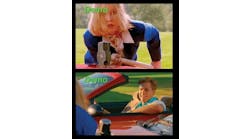When Collision Plus first donated a car to a family in need in 2003, the auto body shop landed on the front page of the local newspaper. Rehabbing the vehicle, which was part of AkzoNobel’s Benevolence Program, generated a lot of buzz for the collision repair facility. There was a cover story in the Belleville News Democrat and an area news station ran a segment on the donation. Customers soon began to mention they had stopped in to the shop because they’d heard about the donation. They liked that Collision Plus, which has four locations in southern Illinois and 64 employees, cared about its community.
The uptick in traffic was due, in large part, to the shop’s director of business development and marketing Debbie Brauer. Thanks to her efforts at notifying the local media about the event, folks in the community had the opportunity to become familiar with the shop. Over the years, Brauer has continued to build relationships with members of the press, which has helped her publish press release_notess and news briefs about the shop and continue to build its brand recognition within the community.
THIRD-PARTY ENDORSEMENT
Getting to know the local media is a cost-effective way for shops to connect with the community—and holds a lot of weight with potential customers. “[It’s] an opportunity for them to get their name out there as an expert in their industry without spending a lot of money,” says Jessica Powell, president of Emerge Interactive Media in Tulsa, Okla., which helped Trinity Restoration win media coverage when it wanted to boost growth. “It has a lot more credibility and strength than just placing an ad in the newspaper. In an ad, you’re telling people you’re great. A news station is supposed to be unbiased. It’s a third-party recommendation.”
MEDIA SAVVY
So how do you get that third-party recommendation? Brauer, who came to Collision Plus with a sales background and learned the ropes of establishing media connections while on the job, says anything that makes your shop stand out is good fodder for press coverage. A shop award, a free car wash for customers, a blood drive, a food drive, a significant shop anniversary, a car giveaway or a Toys for Tots event are all possible news stories.
Now a seven-year veteran at working with local media, Brauer shares how she got Collision Plus in the paper—and kept it there:
Know your contact. Your best bet for media coverage is knowing where to send your news. “Call your local newspaper and get the name of the specific person for that particular type of story,” Bauer advises. Reporters are assigned different beats for particular sections of the newspaper. By pitching your story to the right editor or reporter, you avoid wasting your time and theirs.
Target the right section. News-papers often include columns that announce various business events in the community, Brauer says, and those are ideal spots for coverage. For example, the The Belleville News Democrat includes a “People in Business” and “Around Town” section. Sending your press release to the appropriate journalist increases your chances of getting covered.
Get noticed. Reporters receive numerous press releases and media announcements. To help your news catch their attention, Brauer suggests making a quick call to tell the reporter a release is coming their way. Then, when sending the release, she emails it. “It’s so quick,” she says, and “faxes can get lost in the shuffle.” Take extra care in writing the email’s subject line. Be specific, and offer compelling information. For instance, Brauer writes “Car donated to needy individual at Christmastime” as the subject of her email when sending a press release about the shop’s car giveaway.
Learn by example. If you’re nervous about crafting a savvy press release, take heart, Brauer says. She learned the ropes simply by searching the Internet for “How to write a press release.” She studied those examples and reviewed news stories similar to the kind she hoped a reporter would write about Collision Plus. “I learned by trial and error,” she says. If you don’t have a specific marketing professional at your shop—or don’t have the resources to hire one—studying others’ work is a cost-effective way to go.
Establish relationships. Kindness—and a genuine interest in getting to know local reporters—goes a long way toward building rapport with your media contacts. “Form a personal relationship with them, so it’s [not always] just business,” Brauer says. She’ll often spend a few minutes making friendly small talk, chatting about things that aren’t media related. Keep your chats short, though, so you can move on to the main purpose of your call.
Take advantage of free publicity. Most newspapers have a local business section that publishes company press releases at no charge. “It may just be once a week,” Brauer says, but it beats paying to have your press releases published. Another great venue for free promotion? Brauer recommends local Chamber of Commerce newsletters.
Be willing to lend a favor. If certain reporters and editors are great about providing media coverage, show your appreciation by advertising in their publication. Although your advertisement is no guarantee of continued coverage, it’s a nice “thank you” for their support of your business—and since you’ve already identified the value of appearing in that newspaper editorially, buying an ad there is likely a logical extension of your media strategy.
BUILDING YOUR BRAND
As the sole marketing go-to person at Collision Plus, Brauer has developed a system for working efficiently with the local media. Mainly, she created a template that she uses for emailing press releases. “I already have the form made up with everyone’s email address. [I] just go in and change the story.” As a result, she sends her news in a matter of minutes.
Brauer’s relationship with the local media has helped Collision Plus gain publicity it might not have had otherwise. More important, the news coverage builds brand awareness for the shop in the community. “If we can get that top-of-mind awareness, then we’ve done our job,” says owner Nick Gojmeric. “Even if they call for an oil change, and we don’t do mechanical services, I still think that’s a good thing—at least they’re thinking of you.”
Adds Brauer: “We’ve shown our goodwill and our quality, and [that’s something] people remember.”

